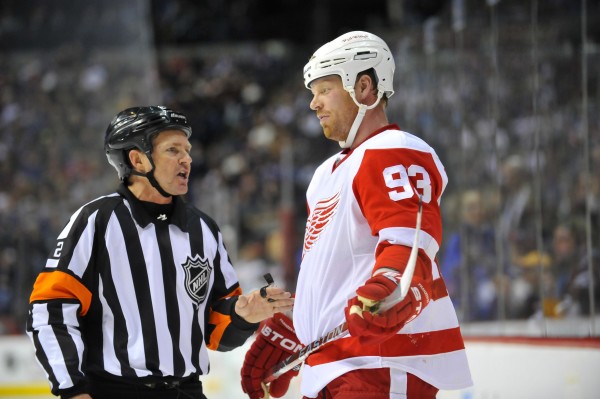
The Last NHL Officials To Work Without Helmets
On-ice safety for players in multiple facets has been a hot-button topic around the NHL for years, and while some players still chose to go helmetless during the mid-90s, it was officials – not players – who were the last to adopt helmets in the NHL.

If you’re an NHL trivia head, you probably know Craig MacTavish is famous for being the last player to forgo wearing a helmet in an NHL game. Additionally, that game was played at the conclusion of the 1996-97 NHL season.
But many fans might be hard-pressed to name Mick McGeough as the last on-ice official to work a game without a helmet, or that the game was played nearly a decade after MacTavish hung up his skates as the last helmetless player.
That’s right. McGeough was the last person in NHL game action without a helmet, and it was during Game 5 of the 2006 Stanley Cup final between the Edmonton Oilers and Carolina Hurricanes.
Close your eyes, and imagine. It’s 2006, post-lockout, a new era of NHL hockey. Concepts now deemed archaic, like ties and two-line passes, were gone. Yet one man donning black and white stripes is racing up and down the ice, his full head of hair blowing in the wind, seemingly going against all common sense safety advice.
By the end of the night, McGeough was confirming Edmonton folk hero Fernando Pisani’s overtime-winner to force a Game 6 north of the border. But little did anyone at the former RBC Center know that a long chapter of NHL history had come to a close with that goal.
[embed]https://www.youtube.com/watch?v=xrn5Mhxa46w[/embed]
A new collective bargaining agreement for the National Hockey League Officials’ Association (NHLOA) in 2006 meant all officials were required to wear a helmet the next season.
Beginning in the 2006-07 campaign, McGeough sported a helmet for the first time in his career, before retiring in 2008.
While the NHL made helmets compulsory for players ahead of the 1979-80 season, the NHLOA only made them mandatory beginning with the 1988-89 season, with a grandfather clause inserted.
That clause allowed many officials, some of whom had just begun working in the league – as McGeough did in 1987 – to carry on without head protection for the next couple of decades, while the majority of players had already adapted helmets.
By the year 2000, 11 of the NHL’s 60 referees and linesmen still didn’t wear helmets. And while the majority of them did eventually make the big switch, five officials held out longer than the rest.
Mick McGeough – 2005-06
McGeough, who passed away in 2018, wasn’t just the last helmetless official; he was also part of one of the best-known player-official interactions in NHL history.
In an intense first-round series between the cross-provincial rivals the Toronto Maple Leafs and the Ottawa Senators, Rob Zamuner blasted a puck past goaltender Curtis Joseph, who was contending with heavy traffic in front of him. Furious that the goal wasn’t disallowed, Joseph chased down McGeough into the corner and accidentally wiped him out after losing his balance.
[embed]https://www.youtube.com/watch?v=ycL9ysQWk60[/embed]
Kerry Fraser – 2005-06
Known partially for his signature bouffant hairstyle, Fraser was the second-last official to let his hair fly in the wind. He donned a bucket for the first time at the beginning of the 2006-07 season.
TSN’s James Duthie even poked fun at Fraser with this short mockumentary centered around Fraser’s supposed fear of “helmet hair.”
[embed]https://www.youtube.com/watch?v=dgWuruC6ZZI[/embed]
Kevin Collins – 2004-05
Unlike the previous two, Collins has the distinction of never wearing a helmet during his 28-year career, as he retired one year before the protection was made compulsory.
Among the more memorable games Collins worked was Game 7 of the 1994 Stanley Cup final between the New York Rangers and Vancouver Canucks. In his career, he made 12 finals appearances as a linesman
Paul Devorski – 2004-05
Like McGeough, Devorski evaded the helmet mandate by one year, enabling him to call hundreds of games and seven Stanley Cup finals, all with his bald spot visible.
His first-ever game as a referee was with Collins as one of his linesmen, and Devorski went on to police many of the iconic Stanley Cup finals of the 2000s, including the intense finals matchups between the Pittsburgh Penguins and Detroit Red Wings in back-to-back seasons.
He also handled the infamous 1997 “Fight Night at the Joe” between the Red Wings and the Colorado Avalanche.
Ray Scapinello – 2003-04
Sorry Phil Kessel, but Scapinello is the true NHL ironman. He officiated 2,500 regular season contests and 426 playoff games and never missed an assigned game between 1971 and 2004. For comparison, Kessel holds the all-time record for players with 1,064 consecutive games.
“Scamp” was a constant presence in the game, taking part in an astounding 20 Stanley Cup finals, All-Star Games, the World Cup of Hockey and the Olympics, which was the only time in his 33-year career that he wore a helmet due to tournament rules.
Safety becomes a priority
With the controversy of helmetless officials and accompanying safety concerns finally being resolved when McGeough made the switch, the next battleground on hockey safety opened up regarding visors.
But even that fight is nearing completion. In the 2023-24 season, just six NHLers played without visors: Jamie Benn, Ryan O’Reilly, Ryan Reaves, Matt Martin, Zach Bogosian and Milan Lucic.
That leaves players' and officials' necks as one of the remaining vulnerabilities in the sport. The topic came into focus last year when ex-NHLer Adam Johnson died from a neck laceration during an Elite Ice Hockey League game in Sheffield, U.K.
While the vast majority of players still do not sport neck protection, the incident did encourage players like T.J. Oshie and Erik Karlsson to experiment with the safety equipment.